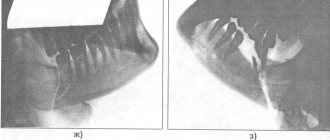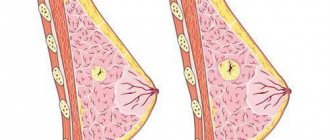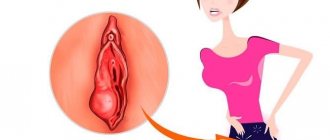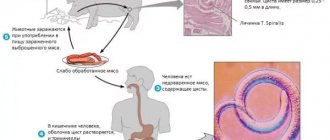A jaw cyst is a dense (fibrous) capsule with inflammatory fluid inside. The medically accepted Latin name “cysta” means “bubble”; an MRI or X-ray actually shows clear rounded contours, reminiscent of a deflating balloon. The diameter of the jaw cyst varies from 5 mm to several centimeters; if the size is less than 5 mm, then it is called a granuloma.
Cysts are benign tumors: the cells are differentiated, their growth is limited to the capsule, and does not spread to neighboring organs or throughout the body as a whole (they do not metastasize). However, if the cyst is not treated in time, it can fester or grow to a large size. The first case threatens with general intoxication, the development of osteomyelitis and sepsis, the second - with compression of neighboring organs, that is, a formation that is benign in cellular composition becomes quite dangerous.
Cysts sometimes open on their own, forming a fistulous tract outward according to the principle of least resistance, for example, through the soft tissue of the gums or into the cavity of the maxillary sinuses. Frequent consequences of any cyst are tooth loss, not only of diseased ones, but also of absolutely healthy neighboring ones. Cysts are especially undesirable during pregnancy, when there are contraindications for the use of certain drugs and surgical techniques, therefore pregnant women need to especially monitor the condition of their teeth.
general description
Unlike the specified granuloma, a dental cyst is a larger formation in size, and it acts as a frequent result of inflammation that occurs in the area of the root of the tooth it affects. As already noted, a dental cyst is shaped like a capsule; this capsule contains inflammatory exudate. The cause of its occurrence can be either infection or trauma suffered by the patient. In this way, the body ensures the localization of the inflammatory process, which is manifested in the formation of a dense type of membrane near the infected dead cells, which, in turn, ensures the isolation of healthy tissues from the progressive spread of infection. The dimensions of the resulting capsule are on average about 0.5 cm, but its dimensions can be several centimeters. In this case, a figure of up to 0.5 cm defines a granuloma, and an increase in size, accordingly, a cyst.
Location of the tooth cyst
It can be assumed that such a process, which occurs when the body independently provides itself with protection, does not carry anything dangerous with it. However, this is not at all true, because the symptoms of a dental cyst require an appropriate approach in order to avoid complications, which otherwise may manifest themselves in the form of transformation of the cyst even into a cancerous tumor, not to mention a number of other, no less serious complications that arise from it. background.
Often, patients have questions related to the growth characteristics of the cyst, or more precisely, how quickly it grows. This formation does not appear suddenly; its appearance is preceded by long-term formation and growth; accordingly, it does not appear “immediately”, unless, of course, the oral cavity is periodically examined by a specialist for pathologies relating to the dentition.
Preventive methods
Prevention is the basis of oral hygiene, which allows you to prevent the occurrence of various diseases associated with teeth. What recommendations do dentists give:
Proper dental care, brushing your teeth in the morning and before bed, and preferably after each meal, will reduce the risk of developing the disease.
- It is necessary to regularly undergo a preventive examination at a dental clinic, perform an X-ray examination of the oral cavity with timely treatment of dental diseases.
- Proper dental care, brushing your teeth in the morning and before bed, and preferably after each meal.
- Avoiding traumatic injuries to the jaw.
- Contact your dentist immediately if you notice any symptoms.
Tooth cyst: causes
The main reason that provokes the development of a dental cyst is an infection, whose development began due to untreated caries; in addition, there are also inflammatory processes concentrated in the sub-coronal area. Chronic periodontitis (which defines such a pathology as a radicular cyst) can also provoke the development of a cyst. A wisdom tooth cyst, the symptoms of which appear as a result of a complicated process of its eruption, is defined as a periodontal cyst.
In some cases, a dental cyst develops in the maxillary sinus; the causes of its occurrence are determined based on certain studies of this formation. Mostly, its appearance is provoked by the presence of a chronic infection in the oral cavity, however, if the cyst did not form because of this, then any conclusions in this regard are drawn based on the results of medical and health therapy measures applied to the teeth. Against the background of sinusitis, patients sometimes develop a cyst on the front tooth. This pathology is accompanied by infection through the bloodstream, as a result of which the cyst begins to grow with the formation of a watery cavity, and this, in turn, causes thinning of the dental bone tissue.
This process does not bypass children, especially newborn babies - they often have baby teeth with purulent cysts, they are also called Bohn's nodes. The formation of such cysts occurs in the area of the gingival plate in the place where first the milk teeth are formed, and then the permanent teeth. In the future, if there are residual effects after the cyst, they can provoke various types of tumor formations. What is noteworthy is that in some cases a cyst in an infant is mistaken for an erupting tooth. Here you should at least take into account the fact that cysts are usually whitish, and their focus does not change in size. In this case, there is no need for special treatment, because the removal of the tooth cyst in this case will occur independently, due to friction between the gums.
Again, injury or improperly performed dental procedures can also lead to the appearance of a dental cyst. The reasons for its appearance include the following:
- periodontitis (an inflammatory process in which the periodontal tissues are damaged);
- pulpitis (an inflammatory process that affects the nerve bundle of the tooth);
- periodontitis (inflammatory process with concomitant damage to periodontal tissues);
- tooth dislocation;
- diseases of the nasopharynx area in a chronic form (runny nose, sinusitis, tonsillitis, etc.);
- caries;
- ARVI;
- weakened immune system;
- smoking, etc.
In an imperceptible form of manifestation, the cyst can worsen, which occurs in particular under stress, hypothermia, physical or mental overload and some other exposure factors. What is noteworthy is that when exposed to these factors, the growth of the cyst becomes especially intense.
It should be noted that the greatest risk in relation to the development of the pathological process we are considering, although it is determined for teeth that have previously been filled or for teeth with crowns, in some cases the possibility of its development is allowed in a tooth that has an outwardly completely healthy appearance. For this reason alone, timely treatment of the cyst becomes possible if patients follow the recommendation regarding mandatory visits to the doctor at least once a year.
Treatment methods for dental cysts
There are different methods of treating this disease; they are used depending on the degree of damage to the tooth by the cyst. Thus, a therapeutic method, laser treatment, treatment with folk remedies and cyst removal can be used. Let's look at each method in detail.
Therapeutic treatment of dental cysts
This method involves treating the tooth with an antiseptic, cleaning and filling . It is effective in such cases as:
- absence of fillings on the root canals that prevent access to the cyst;
- poorly sealed root canal;
- The diameter of the cyst is no more than 8 mm.
The doctor must have access to the cyst using a root canal. First, he disinfects using special means, then pumps out the pus and fills the cavity with paste to form new bone tissue. Next, the root canal is filled and the crown is covered with a filling.
The danger of this type of treatment is frequent relapses, so after the procedure you need to periodically visit the doctor for examination.
Laser treatment
The laser method of treating the formation is the most painless; also, due to laser removal of the cyst, complications practically do not arise.
This type of treatment includes the following stages:
- opening of the tooth and expansion of the canals;
- laser introduction;
- disinfection, inflammation and removal.
The benefits of such treatment and removal are obvious, but there is also a downside. First of all, this is the high cost of laser treatment, as well as the lack of equipment in most clinics, as well as the need to remove the formation.
In addition, after the procedure you should not drink or eat for four hours, which can cause a number of inconveniences.
Video: laser treatment of cysts
Surgical method of treatment
The formation is removed surgically in the following cases:
- if there is a pin in the root canal;
- if there is a crown;
- if the cyst is more than 8 mm in diameter;
- with swelling of the gums.
The cyst is removed under local anesthesia; in some cases, the adjacent tooth may also be removed, for example, if its roots have grown into it, or if it is completely destroyed.
After removal, it is forbidden to apply a warming compress so that harmful microbes cannot multiply and you do not get an infection. Also, after removal, you should not take aspirin for pain relief, so as not to provoke bleeding.
Improvement is usually observed half a day after removal; if the condition does not improve, then consult your doctor again.
Treatment of dental cysts with folk remedies
Naturally, folk remedies cannot be the key to treatment, but they can be used in the presence of the first symptoms of the disease or for the purpose of its prevention.
The most common folk method of treating this disease is rinsing with herbs such as calendula, yarrow, chamomile, sage and others. Herbs help relieve acute pain and disinfect the oral cavity. The decoction should be taken only in concentrated form at the rate of 2 tablespoons of herb per cup of boiled water.
An excellent remedy for relieving inflammation is warm salt water . You need to rinse your mouth with it for two minutes in order to penetrate the solution into the blood. You can also brew herbs in salt water to enhance the effect.
To reduce the number of harmful bacteria, take sesame oil. It can be taken in pure form or combined with a hydrogen peroxide solution.
Among the most popular folk remedies used to treat this disease is garlic. It is cut or grated and then applied to the cyst to kill germs.
Myrrh essential oil , which is consumed in the form of a tincture, is also considered an effective remedy To prepare it, you should dilute about twenty drops of oil in a glass of water, and then rinse your mouth with this tincture for thirty seconds several times a day.
Often, folk treatment includes the use of alcohol tinctures. In particular, they can be used to disinfect the oral cavity and relieve pain. You can also infuse medicinal herbs with alcohol, for example, make horseradish, as well as a tincture based on calendula, ficus or aloe.
To relieve pain after removal surgery, chew a Kalanchoe leaf , retaining the juice secreted by the plant in your mouth, so the wound will heal faster after removal.
Tooth cyst: symptoms
The disease in question is especially dangerous because its first signs appear when this formation reaches a significant size. The early stages of cyst formation occur without symptoms.
As we have already noted, the cyst does not appear immediately, but gradually, forming over many days or even weeks. Accordingly, the appearance of the first symptoms may become noticeable. Symptoms to watch out for include:
- pain in the jaw that does not have a specific localization area;
- the appearance of discomfort in the process of chewing food;
- swelling of the gums.
Also, within the projection of the tooth root, a tubercle forms, over time it changes in size and gradually protrudes - this is how the cyst itself manifests itself. Also, in the future, gumboil may develop and a fistulous tract may form.
With subsequent growth of the cyst, the following manifestations of symptoms can be provoked:
- weakness;
- enlarged lymph nodes;
- elevated temperature.
As we have already noted, symptoms manifest themselves mainly during the late stage of the cyst formation process, that is, precisely when it becomes quite large. If it grows into the maxillary sinus, then in this case the symptoms are accompanied by severe headaches.
A symptom such as toothache does not manifest itself as intensely with a cyst as with other diseases (for example, caries); its manifestation, again, is important to consider when the development of the process reaches a late stage. Pronounced manifestations of symptoms are observed in a situation where this process has reached inflammation of the dental cyst. It is here that pain appears in the damaged tooth, and the development of an acute form of inflammation and gumboil in it. As a rule, it is the exacerbation of the cyst that makes it difficult to ignore.
Tooth cyst: photo
Complications
If a cyst is not detected in a timely manner, it gradually grows, resulting in the destruction of bone tissue while simultaneously replacing it with formations based on connective tissue. Complications of a dental cyst in this case can cause the loss of this tooth. As for other complications, most often they include the following pathologies:
- melting of the jaw bone tissue due to the gradual growth of the cyst;
- inflammation of the lymph nodes;
- purulent form of cyst inflammation;
- development of periostitis or osteomyelitis due to exposure to chronic inflammation;
- development of a chronic form of sinusitis due to the germination of a cyst into the maxillary sinuses;
- the formation of an abscess on the cheek or gum due to purulent inflammation, which is relevant both for the cyst and for the granuloma that precedes it;
- the appearance of phlegmon of the neck due to a long course of purulent inflammation;
- development of sepsis with concomitant blood poisoning;
- a fracture of the jaw of a spontaneous nature, occurring due to significant growth of the cyst with actual thinning of the bone in the area of the base of the jaw.
As you can see, complications in some cases of their manifestation are very serious, therefore, in the case when a tooth cyst hurts, you should definitely seek medical help, because such pain may indicate the onset of purulent inflammation. The smell of pus in the nose should also alert you - this may indicate the onset of an inflammatory purulent process in the maxillary sinuses.
Diagnostics
The only reliable method for identifying a dental cyst is the X-ray method. In this case, a photograph of a dental cyst will determine the presence of an oval or round dark spot with clear outlines. The cyst is mainly concentrated on the root of the tooth, or more precisely, on its apex; identifying it in the image is not difficult. The only exception to this diagnostic method in the presence of a cyst is the option in which it is not visible on an x-ray, which happens if the tooth root is not completely within the scope of the x-ray image, and the cyst, accordingly, is located somewhat beyond its borders. In this case, a repeat image is taken while focusing on another area that covers the entire root system of the tooth, raising suspicions about the presence of a pathological process in it.
Photo of a dental cyst (photo 1)
Photo of a dental cyst (photo 2)
What can you do yourself?
Considering only home methods for treating dental cysts without professional help from a dentist in a clinic, you should immediately make a reservation that completely getting rid of this problem is impossible in this way.
Homeopathic and other folk remedies are used in combination with specialized dental techniques as a necessary addition.
Folk remedies can improve the patient’s general condition, significantly alleviate symptoms and speed up recovery. However, home remedies are not used as the main treatment method.
This is especially true for those difficult cases when doctors recommend surgical treatment with removal of the tumor. Or a therapeutic method with the introduction of certain drugs into the root canals for the purpose of cleaning and disinfection, as well as subsequent filling.
It is simply impossible to do this at home. However, if the cyst provokes the formation of a fistula, home auxiliary therapeutic measures cannot be avoided. Most of them help:
- eliminate painful sensations;
- localize and even completely eliminate the resulting inflammation in the tissues ;
- suppress infection;
- effectively disinfect the oral cavity to prevent further development of inflammation.
What are the symptoms of a dental cyst?
Photos and signs of the disease. How to get rid of caries at home in 1 day? Here are some tips.
Herbal infusions
Many plants have medicinal properties that will help fight a cyst formed on the root of a tooth. Among these properties are disinfection of the oral cavity and elimination of infection, pain relief, and relief of inflammation.
Sometimes, with properly selected folk remedies, the cyst even resolves. The main method of using these beneficial properties is to prepare herbal infusions for rinsing.
The most effective in combating this dental problem are:
- sage;
- creeping thyme;
- yarrow;
- chamomile;
- horsetail;
- calendula;
- eucalyptus;
- medicinal hyssop.
The decoction can be prepared quite quickly and easily. The rules apply to all plants used:
To prepare the medicine, pour two full tablespoons of any selected and pre-chopped herb or a mixture of dried plants with boiling water (about a glass).
Then the container is tightly closed, additionally wrapped in a towel or cloth and left to infuse. The decoction is considered ready after complete cooling.
Decoctions can be used in different ways. The most common of them are mouth rinses , as, indeed, for all other home remedies. A variation of this method is baths , when the liquid is simply in the mouth without moving.
You can also use the lotion - moisten cotton wool generously and apply it to the painful area where the cyst and the area of soft tissue inflammation are located.
After just a few days of daily rinsing 4-6 times , the pain is practically not felt, and the inflammation of the soft tissues is significantly reduced.
Decoctions can also be used for indirect, and in this case, general treatment . Since the cause of the cyst is an infection, and after the formation of the cyst it is its source, the body tries to fight it using its own defenses.
This is not always enough. By regularly taking courses of various herbal decoctions, both pure and mixed, you can strengthen your immune system and help your body get rid of the disease on its own.
What does dental caries look like and manifest itself? Photos of stages, treatment, prevention.
This article contains expert recommendations on what to do if a wisdom tooth grows into the cheek.
Every patient should know why a tooth hurts after filling, if the nerve was not removed.
Alcohol infusions
Alcohol is one of the most common antiseptics in medicine (both professional and folk). It is used not only on its own, but also as various tinctures.
The easiest way to use alcohol to improve the condition of a dental cyst is to briefly rinse your mouth with regular vodka or diluted medical alcohol .
This will help reduce pain and help kill infection and bacteria. It is advisable to carry out the procedure several times a day .
Alcohol tinctures of medicinal herbs act somewhat differently. The excellent antiseptic properties of the alcohol itself are enhanced by the healing, bactericidal, anti-inflammatory effects of additional ingredients.
At the same time, the properties of plants also appear more clearly, since alcohol acts as a catalyst. The most effective for tooth cysts are alcohol tinctures of ficus and horseradish root.
The preparation method will be the same in both cases, as well as for other plants. It is necessary to finely chop the plants (here it is advisable to use freshly picked rather than dried herbs), pour it with medical alcohol in a one-to-one ratio or, in its absence, with regular vodka.
This mixture should be infused for three to five days, depending on the alcohol concentration, in a place that is well protected from children, dark, cool and well ventilated. After this, the resulting product can be filtered so that plant particles do not enter the oral cavity.
Read also: How to strengthen teeth
A cotton pad is soaked in the tincture and applied to the damaged area for several hours. After this, you should rinse your mouth thoroughly, preferably with antiseptic decoctions.
Additionally, you can rinse with alcohol infusion. However, in this case, it is necessary to reduce its concentration using clean, barely warm water, that is, simply dilute it with water.
Salt infusions
One of the oldest, proven, effective and, moreover, completely safe ways to combat the consequences and symptoms of a dental cyst is the old-fashioned method of using saline solutions.
Saline solution effectively relieves inflammation of soft tissues, destroying most of the bacteria and preventing their further development.
Saline solution is used mainly for rinsing. At the same time, all the basic rules for the preparation and subsequent use of solutions remain unchanged. Use only clean, possibly boiled water at room temperature.
For a glass of water - just one teaspoon of regular table salt. For better dissolution, you can pour a small amount of boiling water over the salt, and then simply add cool water or wait until the solution has cooled.
You should rinse thoroughly, holding the liquid in your mouth for a while without swallowing, and the number of procedures can be set independently. It all depends on how much the disease and its manifestations bother you.
It is recommended to carry out the procedure every hour and a half. This break between salt rinses is optimal. However, with the modern pace of life, this is not always possible. Therefore, the frequency of rinsing can be reduced without much damage.
sea salt to prepare the solution . In many cases, this significantly increases the effectiveness of the technique, accelerating recovery, since sea salt contains many minerals and trace elements that have a beneficial effect on the condition of the oral cavity.
Such oils resemble tinctures in their action, but the beauty is that you don’t have to make them yourself, wasting precious time on it. In addition, oils cannot simply be purchased at the nearest pharmacy.
There you can probably find small bottles with compound oils that combine the effects of several plants at once.
It is best to use tea tree, mint, and bergamot oils . Also very effective are the essential oils of those plants that are usually used to prepare decoctions.
In this form, their properties are more pronounced, and, accordingly, the effectiveness of treatment increases. Essential oils are an extremely concentrated product. Because of this, they should be used with extreme caution.
You can prepare water mixed with a few drops of oil, or you can dilute the required essential oil with sesame oil. The latter is also antiseptic and will help in treatment.
Cotton wool soaked in a mixture of oils is applied to the fistula and left for several hours.
Sesame oil is also often used for home treatment of dental cysts. For proper treatment, it is necessary to carry out a certain procedure several times a day (about four to five, sometimes less).
Take one teaspoon of oil and hold it in your mouth for at least seven minutes, without swallowing or rinsing. With this, you can not only control the spread of infection, but also effectively fight it.
In parallel with treatment with sesame oil, you can make compresses from clove oil , which helps relieve swelling of the soft tissues of the gums and significantly reduce inflammation, stopping the further development of the disease.
This video details the healing properties of tea tree oil:
Medications
Additionally, you can use some medications at home. These drugs, which combat the effects of the cyst and its symptoms, can be found in most pharmacy chains and can be purchased for a reasonable price without a prescription (except for antibiotics).
Their use is also quite effective. However, it should be remembered that self-administration of medications without consultation and prescription of a doctor can lead to undesirable consequences.
Therefore, such products should be used with caution, fully following the instructions regarding dosages, methods and duration of use, as well as taking into account contraindications and interactions with other substances and drugs.
The most common medications in the independent fight against dental cysts are:
- hydrogen peroxide;
- permanganate (potassium permanganate, which is sold in the form of a powder of small dark pink, almost black crystals);
- antiseptic solutions , for example, chlorophyllipt for rinsing;
- antibiotics against inflammation, for example, lincomycin;
- nimesil (nimesulide) for inflammation and pain relief;
- various painkillers - ketanov, ketarol, etc.
If you find an error, please select a piece of text and press Ctrl+Enter.











